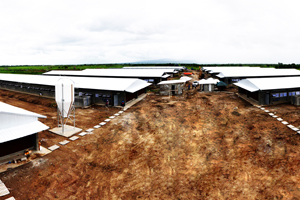CPF steps up its presence in the Philippines

For more than one reason, the Philippines ?is considered interesting for investments. Thailand-based Charoen Pokphand Foods ?managed to enter the Philippine market and aims to make the most of the islands’ ?advantages.
By Apisit Buranakanonda, editor, Feed & Livestock Magazine, Thailand
As is well known, the Philippines is a promising market for pork. The country’s market is characterised by high consumption rates and a fast growing population of 100 million, which is increasing at a rate of 2% annually. Pork is by far the dominant meat product, accounting for 60% of total livestock production, with poultry coming second at 27%. Annual per capita pork consumption in the Philippines is 15 kg and consumption is likely to grow further as consumers become more affluent. Currently, due to high raw material costs, the Philippines imports 62,000 tonnes of pork from the US and Canada.
Leased feed mill
Taking this into consideration, it may not come as a surprise that many large agricultural companies have found a way to access the Philippines – and so has Thai meat giant, Charoen Pokphand Food. CPF Philippines was established in 2010 with a leased feed mill in Guiguinto Bulacan, 35 km north of Manila. The mill operation allowed the company to familiarise itself with the market and prepare the groundwork for future livestock businesses.
CPF Philippines first launched commercial feed in the first quarter of 2011, with full capacity planned for the fourth quarter of 2012. Its marketing network was to cover all 38 provinces in the Luzon Island and Manila area, up from 20 provinces initially. At full production, it is able to cover an area ranging up to 200 km north of the plant and 400 km away in southern Luzon. Its core product is CP brand complete feed.
The plant produces creep, grower, finisher and piglet feed for hogs. It also produces breeder feed for internal use. In addition, it produces pelleted and crumble feed for broilers and mash feed for layers.
Advantages
CPF aims to step up its pig (and poultry) business in the Philippines – and early 2012 the Philippine Board of Investments allowed CPF Philippines to raise hog parent stocks and slaughter pigs in the country. The company subsequently started a project of three swine farms, with the total investment cost being €24.1 million.
A distinct advantage of operating in the Philippines is the fact that the country is free of Foot-and-Mouth Disease (FMD) as well as avian influenza. That means the Philippines could serve as a hub for exporting frozen or chilled chicken and pork to Japan, Taiwan, or Korea, explains Arnnop Jeanprasert, vice president for the company’s livestock feed business.
CPF’s first batch of pure line hogs arrived in 2012 at Clark International Airport, Luzon Island – and the first finishing hogs from that group will be hitting the market by the end of 2013 or early 2014. The animals were imported directly from Canada and are made up of the Landrace, Large White, and Duroc breeds. The selection was based on a market survey that found that Philippine consumers prefer lean meat.
By 2015, CPF Philippines is targeting the operation of hog parent stock farms. Such farms could be either wholly owned or run by up to 100 contract growers. The top pyramid breeders will be reared at a CPF farm in Pampanga province, Luzon Island.
New feed mill
CPF Philippines will also build a new US$30 million feed mill in Gerona, Tarlac, to support livestock expansion, says Arnnop. Gerona, 140 km north of Manila, was selected for the new mill due to the abundance of corn in Pangasinan and Isabela and its close proximity to a major animal production area. In the future, livestock producers are expected to move to the northern provinces due to urbanisation pressure in central Luzon and Manila. The new plant will secure a foothold for the company for supporting future growth in its feed and farm operations in the coming years, concludes Arnnop.
The local market is highly competitive with a full complement of local and international players such as Cargill (Purina), China’s New Hope, Korea’s CJ, Sunjin and Ifeed – a subsidiary of Easy Bio. Nevertheless, the market is still growing due to the country’s continuing population growth.











